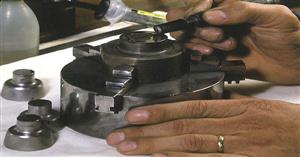How do we strike coins today?
The final and actual minting stage is the transfer of the design to the metal coin blanks to be
struck. As in days of yore, modern coin presses consist of two important components - one working die
for the obverse and another for the reverse, and a collar. Coining presses are designed for any
denomination of coin. Dies and collars are interchangeable and striking pressures are adjustable for the various
denominations and metals.

The collar is a circular piece of hardened steel which acts as the wall of the coining chamber,
which provides the impression for the uniform circular outline around the coin. As its name implies, the collar
prevents the striking pressure from spreading onto the flange. Apart from preventing imperfect strikes, the
impression on the coin's edge (either as a recess or raised inscription) deters forgery or clipping (an illegal
paring of metal from the circumference of the coin). The dies impress the various designs and devices on the
obverse and reverse for the coin while the collar forms the edge of the coin. The collar, which is
five-thousandths of an inch larger in diameter than the dies, is mounted on springs which allow slight vertical
movement.
The striking process
Generally, the reverse die is the lower (or anvil) die while the obverse die is
the upper (or hammer) die; however, there are exceptions, and on some presses, the dies are
mounted horizontally so that they move parallel to the floor. Still, the titles anvil die and hammer die are
appropriate.
Planchets are fed by gravity from a basin attached to the press through a cylindrical tube. This
tube stacks 20 or so planchets. From this stack the bottom planchet is fed into the press by one of several feed
devices. One device is called the feed fingers: two parallel pieces of metal joined in such a way
that they can open and close; on one end of the two pieces is a covered recessed slot and in the center is a hole.
A second device is a dial feeder: a circular piece slotted with holes which transport the
planchets to the coining chamber and then transport the newly struck coin from the dies.
No matter which feed device is used, the coining process is the same. The anvil die at this
point is stationary. As the hammer die moves toward the anvil die it impresses the designs of both sides into the
planchet and then completes its cycle by moving upward to its original position. On presses using the dial feeder,
the dial remains stationary so that the hole transporting the planchet remains centered over the anvil die, with
the hammer die passing through the hole to strike the coin. Now the anvil die starts to move above the collar,
actuated by an eccentric cam, raising the struck coin out of the coining chamber. Presses fed by dial feeders have
sensors that automatically stop the press if a planchet is mispositioned, of the wrong size or incomplete, or is
completely missing. The Denver Mint especially has good use of this feature to largely eliminate many of the error
coins that entice collectors.
Proof blanks are manually fed by hand into automatic presses which can strike almost 100
commemorative coins per hour. The high quality required for proof coins does not allow any mass production.
Inspection for errors
Frequently, while a press is in operation, the press attendant will pick up a finished coin for
inspection to catch some of the remaining varieties and errors that are still produced. The inspector examines the
coin under a magnifier and it reveals any defects made in the die during operation. Another attempt is made to
prevent improperly shaped coins from reaching circulation by passing them through a second riddler. Throughout the
minting process, computers track such statistics as the productivity of each press operator, any repairs to a
coining press, quantities of coins struck per press, plus installation, movement and destruction of the dies. The
machines are able to produce about 250 to 800 pieces of coins in a minute.
Packing and shipping
After passing the inspection, the minted coins are counted automatically by machines, weighed
and bagged or boxed. This is done when the coins proceed to a hopper placed by the minting machine. Once the hopper
is filled, it is sent to the counting and packing section. The coins are counted according to denomination and are
then dropped into buckets which travel by conveyor system to the bagging machine. Here, the coins fill into
plastic bags, are sealed, weighed and printed with denomination, date, value and serial number. The bagged coins
are then packed into wooden crates, strapped tightly with the mint seal, weighed again and finally arranged on
pallets before they are delivered to local banks on an as-needed basis.